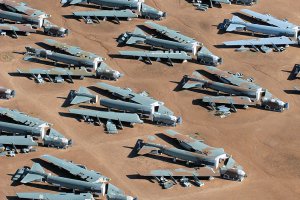In 1991 the Strategic Arms Reduction Treaty (START) was signed by the US Russia, Byelarus, Kazakhstan and Ukraine, its aim was to reduce the total number of strategic nuclear delivery vehicles intercontinental and submarine launched ballistic missiles and also heavy bombers. As a result the US made a commitment to eliminate many of its Boeing B-52 Stratofortress aircraft to stay within the limits set in the agreement. Under the agreement the US could retain 71 B-52 bombers, each equipped to carry 20 cruise missiles.
AMARC was given the awesome task of eliminating the very large number (approx 365) of these very large aircraft to the timescales laid out in the treaty. By 1998, 252 B-52's had been destroyed with a further 113 still at AMARC. The last of the B-52 eliminations to be included in the treaty were scheduled to be completed by the end of 2001.
Boeing B-52F Superfortress 57-0045 after elimination at AMARC. Notice how the aircraft has been ripped apart with very little care to preserve the remains. © Bob Shane.
Boeing B-52G Stratofortress 58-0244 being stored in Area 26 after having been cut up in a more careful way than B-52s were in earlier years. This approach helps preserve the reusable components which can be reclaimed at a later date. © AMARC Experience.
Boeing B-52 Superfortresses neatly laid out in Area 26 during 2001, ready for inspection by Soviet satellites. © AMARC Experience.
The distinctively colored Control Configured Vehicle (CCV), fly-by-wire Boeing NB-52E Stratofortress 56-0632 after elimination. Its trademark needle nose can be seen laying on the ground in front of the cockpit section. © Bob Shane.
A Boeing B-52 Stratofortress being transported to a local metal processing company following its elimination and verification was completed at AMARC.
Originally AMARC used a 13,500lb guillitine blade to slice through each B-52. The blade was hoisted to a height of 80 feet using a crane and then unceremoniously dropped on each predefined cut point. This approach was very effective in slicing through the airframe. The resulting sections of the aircraft were arranged for easy identification to satellite (the main verification method used by the Russian and Ukranian observers) and after 90 days the wreckage was sold to local scrap metal companies for disposal. Some 150,000 pounds of aluminium and other metals were available for recycling from each aircraft.
AMARC have progressed from this 'brute force' elimination method to a more 'surgical' method using power saws. The reason for this is that the B-52G's have many components that can be used to support the operational B-52H's, the guillitine method made it very difficult to preserve the interior of the aircraft after the operation. By using power saws, precision cuts are made and afterwards spraylat (the same material used to preserve the other aircraft stored at AMARC) is used to seal any holes exposing interior areas of the aircraft. Spare parts can then be retrieved at a later stage without fear of degradation due to exposure to sun, rain and dirt.
START I expired on December 5th, 2009.
New START
On April 8th, 2010 a new treaty was signed in Prague between the United States and the Russian Federation which agreed to the further reduction of strategic nuclear weapon numbers by both countries. The treaty, was given the name 'Measures for the Further Reduction and Limitation of Strategic Offensive Arms', but it is more commonly known as New Start. The agreement reduces the limit on the number of deployed missiles and bombers down to 700 and is expected to be in effect until at least 2021.
During 2011 Boeing B-52G Stratofortress 58-0197 became the first bomber to be eliminated under the New Start agreement. AMARG crews dissected the aircraft into two large pieces by making a surgical cut through the rear empennage, severing the tail and horizontal stabilizer. New Start calls for the elimination of a further 38 of the stored B-52G bombers.















